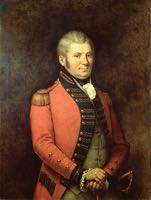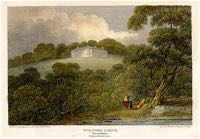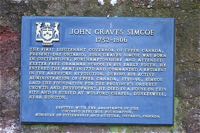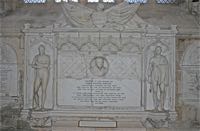
John Graves Simcoe - first Lieutenant Governor of Upper Canada
Page updated 2nd September 2016
Return to Exeter People Menu
Born on the 25 February, 1752, John Simcoe was raised in Exeter by his mother and educated at Exeter Free Grammar School, Eton before attending Merton College, Oxford for a year. Initially he attended Lincoln's Inn to study for the law, but changed to follow a military career. He was initiated into Freemasonry in Union Lodge, Exeter on November 2, 1773.
He embarked on a military career in 1770 when he secured a commission as an ensign in the 35th Regiment of Foot. After fighting in the American War of Independence, he returned to England and married.
He married his wife, Elizabeth Posthuma Gwillim in 1782–she was his godfather's ward. Elizabeth was a wealthy heiress who owned 5,000 acres of land at Honiton, Simcoe built Wolford Lodge, which remained in the family until 1923.
Governor of Canada
In 1791 he was appointed as the first Lieutenant-Governor of Upper Canada, arriving in the new province in June 1792. He was accompanied by his wife Elizabeth and their two youngest children.
Although there had been considerable settlement in the eastern Upper Canada, the province was still a wilderness. Simcoe introduced a British system of government. He planned military strategy for defending Upper Canada against the United States and pushed some key roads through the wilderness to aid troop movements, increase settlement and encourage trade. The founding of Toronto was due to Simcoe.
Due to Simcoe, slavery was abolished in Ontario, Upper Canada in 1793, during the second legislative assembly, and was the first place in the British Empire to introduce a ban, despite opposition from the British Government. He also campaigned, unsuccessfully, to ban slavery in Haiti, encountering fierce opposition from the British Government. It is probably for this work that he remained an untitled commoner, never gaining the recognition he deserved. The Canadians have mistakenly, (or proudly) dubbed him a Lord, with the naming of the Lord Simcoe Hotel in Toronto, and Lord Simcoe Drive in Ontario.
Return to England
He returned to England in 1796 due to ill-health. In 1806, he was appointed Commander in Chief to India. While his wife stayed in London to prepare the family for the move, he set sail for India. He became ill early in the voyage and was landed at Torbay, where he was conveyed to Topsam. He died on Sunday 25 October. He left his widow Elizabeth and nine children. He was interred at Wolford Lodge.
His family coat of arms carries the following legend.
NON SIBI SED PATRIAE
(Not for self but for country).
│ Top of Page │



